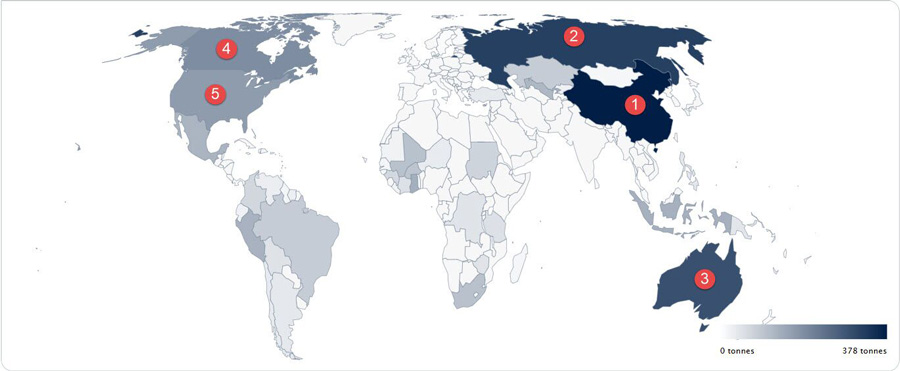You’ll Be Amazed How Much Higher Gold’s Price Can Go…
Peter Reagan
 With $3,000 gold price well behind us, what’s ahead? With $3,000 gold price well behind us, what’s ahead?
Last week, the price of gold ended just short of $3,050 – and remained above $3,000. That means it’s time to ask what’s next. (Just in case you’re a new reader, I’ll quickly cover the factors that have brought gold this far.)
Last week, I noted that everyone was treating $3,000 gold as a foregone conclusion. I certainly didn’t expect such instant validation! Analysts were one or two weeks ahead of the gold market.
So what happened? Well, both the nature of the rise and the firm support above $3,000 so far seems to’ve been triggered by Thursday’s confirmation that Federal Reserve still intends to cut rates twice in 2025. (That seems to throw any chance of rate hikes out the window – and that means, almost certainly, rates have gone as high as they still can. Personally, I interpret this as Powell’s admission he’s powerless to stop stagflation…)
Contrary to all conventional wisdom, the recent rate-hiking cycle was the environment in which gold made its greatest run in modern history.
Analysts apparently expect the cuts to happen near the end of 2025, which could prolong the cutting cycle for as long as a few years. The economy seems to be shuddering on the very edge of stalling speed, and the Fed simply won’t leave rates where they are in the face of a confirmed economic slowdown.
What's the problem with the usual boom and bust cycle this time around? Other than the obvious, of course…
This time, there are clear indications that the Fed’s “dramatic” tightening of the money supply, the “shock and awe” of the “largest rate hike in decades” simply didn’t work. The “transitory” inflation of the pandemic panic is still hanging around, haunting the economy at large and every single family in the U.S.
Fiddling with their money-supply tracking metrics (and ending some data collection completely) – and a stubborn insistence on relying on completely inaccurate inflation data didn’t solve the problem? Well, how about attempts to “normalize” permanently higher inflation? It’s easy to see what’s going on here…
On the other side, we have experts like Alasdair Macleod arguing that this wave of inflation wasn’t caused by money-printing. Rather, it’s down to a complete loss of trust in the greenback.
If his hypothesis is correct, it’s easy to see why the Fed’s attempts to control inflation hasn't accomplished much. Because it cannot accomplish much.
Now, any loosening of monetary policy in the U.S. will result in higher gold prices simply because lower rates weaken the U.S. dollar. When the dollar goes down, gold goes up.
That's a major reason everyone is bullish. We are seeing an almost certain few years of rate cutting ahead – and that’s very beneficial for gold.
Now, the reverse used to be true – a stronger dollar was terrible for gold’s price. “Everyone” knows that. Right? Well, here’s the problem… When the Fed’s super duper massive unbelievable interest rate hike of 75 basis points – almost a whole percent! – was announced on June 15, 2022, what was gold’s price? $1,810 an ounce. Thirty-two months later, gold is over $3,000 an ounce.
Rate hikes didn’t work. We still have persistent inflation! So what’s going on?
Simply this: U.S. dollar purchasing power is based on supply and demand. Historically, raising interest rates lures capital into dollars (when even a savings account offers a risk-free profit, there’s a lot of demand for cash!) But today, the supply of dollars is growing at over $1 trillion a year from the government’s interest payments alone! Deficit spending generates even more.
The endless dollar supply glut has overwhelmed whatever limited control the Federal Reserve’s interest rate levers can apply.
Essentially, that means it’s anyone's guess as to how high the gold price can go. Maybe you call this an exaggeration? I direct you to the words of Kenneth Rogoff, chess grandmaster, Harvard economist and former chief economist at the IMF:
Gold, despite being in nearly fixed supply, does not have this [supply] problem, because there is no limit on its price.
The upside is unlimited. Especially over the coming decade or two. A thought that may fill you with joy if you’re already a gold investor.
Ole Hansen also went deep into it in his latest piece, showing that gold is powered by both long and short-term drivers that will be difficult to remove. He also said that this move shows growing global instability, which seems to suggest some kind of reintroduction of gold to the monetary system.
In short, it’s a great time to be a gold IRA owner.
This could be the worst possible time to attempt a bearish analysis of gold
After months and months of scouring, expedition and all, we managed to find it: a full-blown bearish take.
It comes courtesy of analyst David Sekera, who says gold could eventually retrace to $1,820, a level last seen in October 2023.
There are already a few problems here, and we are barely into the analysis itself.
For starters, October 2023 isn't that far back, and when gold hit $1,820 then, it was viewed as highly bullish.
If gold's run was slower-paced, it would be neither inconceivable nor bearish for the metal to be $1,820 now, given that interest rates are still very high.
So the narrative starts to fall apart already, as have the previous ones we've covered, and it only gets worse the deeper we go in.
He says real interest rates are positive and should remain so throughout 2026.
But they are only relatively positive because of the tightest hiking schedule in 50 years. That cycle is reversing now, so what he's saying is that real interest rates might have a year and half more of life before tanking again.
How does this factor in gold going to $1,820 in the next few years? Shouldn't gold go up as these rates lower more and more?
Sekera is very optimistic on inflation, saying the Federal Reserve will catch its 2% target when:
- Seemingly nobody believes inflation is 2%, placing the real figure anywhere between 4%-10%
- Consumer prices are spiking across the board, giving off the exact same vibe of the past few years, and…
- There is ongoing talk of normalizing the 4% inflation rate because why not
Our favorite bit, though, is so-called destruction demand, where Sekera says manufacturers will deal with high gold prices the same way they do with silver: thrifting.
As he says, jewelry manufacturers will probably start using lesser metals to deal with production costs.
But unlike, say, solar panels, you can't exactly thrift gold in jewelry. People buy gold jewelry because of gold.
It's easy to assay how much gold jewelry has, and any manufacturer thrifting gold in jewelry would soon face the consequences on the consumer end.
So the arguments get increasingly bizarre, making us wonder if these kinds of analyses are even serious.
We are no longer in 2011 or 2012 where there is some faith in money. A fall on behalf of gold akin to that between 2011 and 2013 isn't going to make people wonder if it was an unreasonable frenzy.
No, $1,820 gold would trigger buying by just about everyone, starting with central banks by the ton. If they're buying 1,000 tons of gold annually when gold is around $3,000, what will happen should it go to $1,820?
The level many late entrant dreams of, but not one we'd bet on. Sekera is giving monetary projections five years down the line.
With how the last five years have went, we don't even want to imagine what monetary screw-ups will happen in the next five.
Locally-sourced central bank gold bullion could be the start of a global supply problem?
Gold supply has come up as a problem recently – which may come as a surprise.
It's as if out of nowhere, we started hearing that miners are cutting down not because gold fell, but because inflation is making miners’ operating costs too high for profitability.
Remember, miners normally cut back when gold price falls. (Same with copper and iron mines – same with any company.) But gold’s price has been gaining rapidly. Now is the time to start new projects, to identify and evaluate new projects, to expand production at proven sites – to mine more gold. But, apparently, they can't afford to.
That’s one strand. Then there is the whole saga of COMEX shipments which, while not on the same scale, still falls in the same category.
Countries like Vietnam are struggling to provide gold for its citizens, while many others contend with exorbitant premiums.
This brings us to a very interesting note by Shaokai Fan, global head of central banks at the World Gold Council, who recently mentioned that more and more countries are buying gold locally.
We've already covered this to some degree, but it's clearly gaining more traction, and it doesn't take much insight to see why this could be huge for gold.
It all boils down to a basic question: If every gold-producing nation is buying its own gold, then who's supplying goldfor everyone else?
Gold supply is extremely localized! Only a few countries are really worth mentioning.
These would be China, Russia, Australia, Canada and the U.S.

Map of gold mining nations via World Gold Council. Top 5 gold producers indicated.
Russia and China, by this point, are to be assumed to be pouring all the gold they produce into their own central banks, either directly or through proxy purchases.
Russia might be selling some gold to stay afloat due to the SWIFT ban, but we know they’re still transitioning their nation away from the global financial system. Gold helps them make that shift. No wonder Russia now ranks #5 among official sector stockpiles (surpassing even China!).
Where is the gold coming from? Its own domestic mines, primarily. Same for China – in fact, in China it’s illegal to export domestically-mined gold.
In an even more interesting turn of events, African nations are increasingly turning to buying their own gold, whether for national reserves or other purposes. And why shouldn't they? The West is actually making it harder for them to do business, not unlike as in Russia. Illegal gold and all. For example:
International scrutiny over Rwanda's gold supply chains will intensify, and increased oversight may restrict access to legitimate buyers.
The economic impact could strain Rwanda's balance of payments, weaken the national currency, and lead to financial instability.
Diplomatic fallout will likely escalate tensions between Rwanda, the EU, and DR Congo, potentially leading to further trade restrictions, reduced foreign investment, and international isolation.
The sanctions present a serious challenge to Rwanda's economic and diplomatic standing.
In other words, the European Union wants to do to Rwanda what we did to Venezuela.
Trouble is, Rwanda is where the gold comes from. This is just one of many examples, of course.
Other nations aren't being forced to buy up local gold, but are simply doing so of their own volition, taking other central banks' cues and wanting something stable to their monetary system. So an increasing number of the very small number of gold-producing nations is all but buying all the gold they mine.
Should this continue, where is gold supposed to come from 5, 10 or 20 years down the line?
This is a development that is one to keep an eye on, even though the issue is flying under the radar. As usual.
After all, most analysts can’t even figure out why gold’s price is above $3,000, right?

Peter Reagan is a financial market strategist at Birch Gold Group. As the Precious Metal IRA Specialists, Birch Gold helps Americans protect their retirement savings with physical gold and silver.
www.newsmax.com
| 

